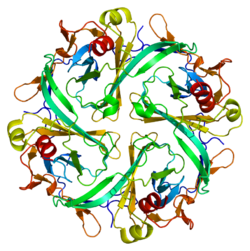The Kir2.1 inward-rectifier potassium channel is a lipid-gated ion channel encoded by the KCNJ2 gene.[5][6][7][8]
- ^ a b c GRCh38: Ensembl release 89: ENSG00000123700 – Ensembl, May 2017
- ^ a b c GRCm38: Ensembl release 89: ENSMUSG00000041695 – Ensembl, May 2017
- ^ "Human PubMed Reference:". National Center for Biotechnology Information, U.S. National Library of Medicine.
- ^ "Mouse PubMed Reference:". National Center for Biotechnology Information, U.S. National Library of Medicine.
- ^ Hansen SB (May 2015). "Lipid agonism: The PIP2 paradigm of ligand-gated ion channels". Biochimica et Biophysica Acta (BBA) - Molecular and Cell Biology of Lipids. 1851 (5): 620–8. doi:10.1016/j.bbalip.2015.01.011. PMC 4540326. PMID 25633344.
- ^ Raab-Graham KF, Radeke CM, Vandenberg CA (1994). "Molecular cloning and expression of a human heart inward rectifier potassium channel". NeuroReport. 5 (18): 2501–5. doi:10.1097/00001756-199412000-00024. PMID 7696590.
- ^ Derst C, Karschin C, Wischmeyer E, Hirsch JR, Preisig-Müller R, Rajan S, Engel H, Grzeschik K, Daut J, Karschin A (2001). "Genetic and functional linkage of Kir5.1 and Kir2.1 channel subunits". FEBS Lett. 491 (3): 305–11. Bibcode:2001FEBSL.491..305D. doi:10.1016/S0014-5793(01)02202-5. PMID 11240146. S2CID 14452157.
- ^ Kubo Y, Adelman JP, Clapham DE, Jan LY, Karschin A, Kurachi Y, Lazdunski M, Nichols CG, Seino S, Vandenberg CA (2005). "International Union of Pharmacology. LIV. Nomenclature and molecular relationships of inwardly rectifying potassium channels". Pharmacol. Rev. 57 (4): 509–26. doi:10.1124/pr.57.4.11. PMID 16382105. S2CID 11588492.





